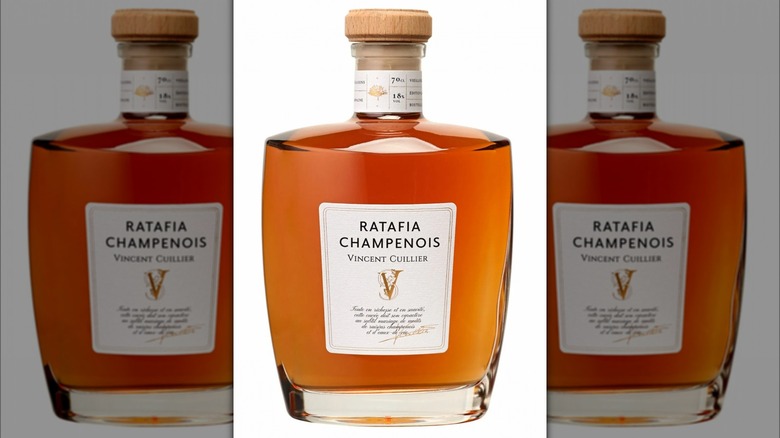Ratafia Champenois: The Liqueur Made In Champagne
It's a mighty bleak picture to envision a world with an insufficient supply of Champagne, though it appears that's where we're headed. Robb Report recently warned that 2023 and 2024 are likely to see Champagne producers who are unable to meet global demand for their bubbly wares. The reasons for the upcoming Champagne shortage are two-fold: First, Champagne's trade association of growers and producers mistakenly assumed the Covid-19 pandemic would cause Champagne sales to tank, so they reduced the grape harvest by 20%. Second, the harvest itself was poor, thanks to difficult growing conditions over the season (per The Drinks Business).
The fact that Champagne sales didn't plummet during the pandemic though harvests were reduced, coupled with the disastrous 2021 harvest means that Champagne producers are unlikely to have sufficient base wine on hand to produce their non-vintage Champagnes, wines that are typically at least two years in the making. That's bad news for Champagne fans in 2023 and 2024.
But there's a bright spot in this dismal world sans prestigious bubbles, and that's Ratafia Champenois, the little-known gem of a liqueur that might not only rescue the livelihood of small producers but may also acquaint the world with a heavenly liqueur that's been under the radar for far too long.
What is Ratafia Champenois?
According to Decanter, Ratafia Champenois isn't new, but it may be new to consumers. The liqueur is made from the third and fourth pressing of the very same grapes used to make Champagne, so it's made from one or more of the following varieties: Pinot Noir, Pinot Meunier, and Chardonnay. After pressing, the wine is fortified with grape-based brandy, Wine Enthusiast explains, making the finished Ratafia Champenois a vin de liqueur, or sweet, fortified wine. Glass of Bubbly describes the flavor as "creamy and smooth tasting sweet liqueur expressing plenty of grape juice, almonds, marzipan and ripe fruits in syrup sauce."
Decanter points out that while Ratafia Champenois was recognized with a Protected Geographical Indication in 2015, its history dates back 800 years, and there are currently 120 Ratafia Champenois producers. The president of Boissons Spiritueses Champenoises, the organization regulating production of Ratafia Champenoises, expects production to grow to roughly 15 million bottles annually.
Emmanuelle Giraud, CEO of Champagne Henri Giraud told Robb Report, "At Champagne Henri Giraud, we could not fulfill all the orders in 2022 but we had the chance to replace this Champagne shortage by a new offer, which is Ratafia Champenois. It is also going crazy worldwide. In fact, in 2022, it was a chance for our partners around the globe to discover our Ratafia." While Ratafia Champenois may not have bubbles, it's an opportunity to taste another expression of Champagne.

